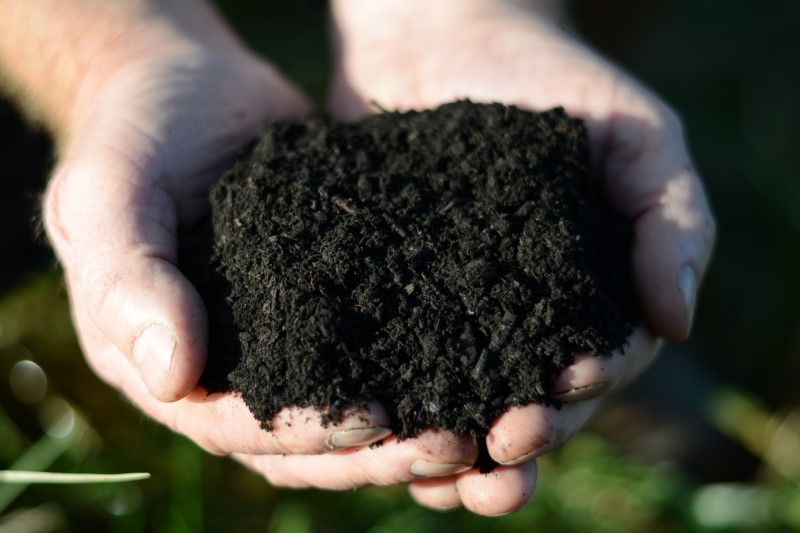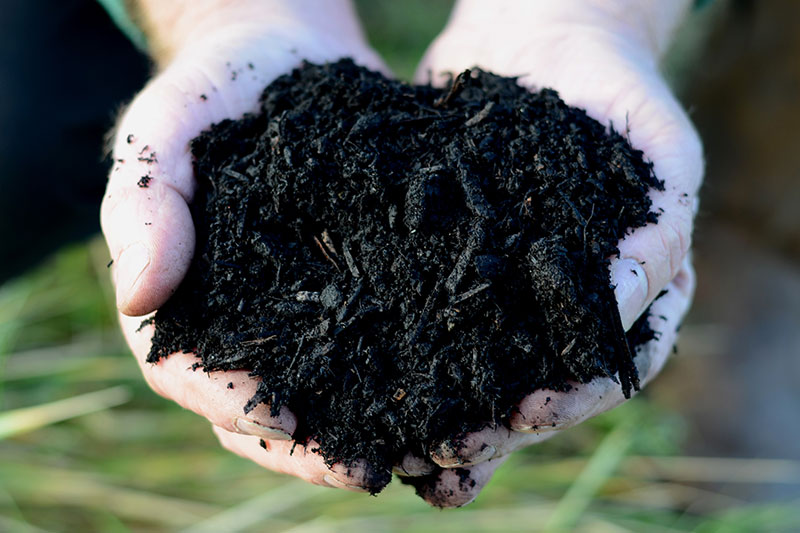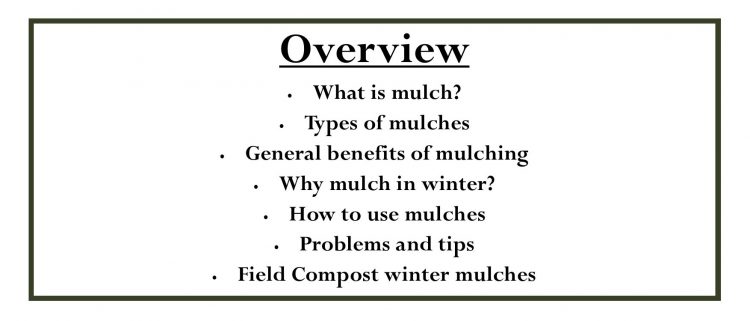
What is mulch?
Mulching is the practice of spreading a thick layer of compost, bark, or manure matter across the surface of soil and around plants. Mulches can be applied around new plantings or to established beds and specimen plants.
Field Compost has several mulching products, each made for different specific purposes. Click here to browse all our mulch products or keep scrolling to see which mulches we recommend for winter.
Field Compost stock organic/biodegradable mulches, but mulches can also be inorganic/nonbiodegradable:
-
Organic:
- E.g., bark chippings, homemade compost, shredded trees, straw, leaf mould, or grass clippings.
- These mulches are easier to maintain as they can be replaced by another layer when have rotted away.
- Organic mulches contain nutrients; as they decompose, they release these nutrients into the soil, acting as a slow-release plant food.
- Best for woodland gardens, borders, and around longer-term food crops (e.g., courgettes, strawberries, fruit bushes, and asparagus).
-
Inorganic:
- E.g., shingle, gravel, slate chips, plastic sheeting, or landscaping fabric.
- It does not break down, but some products disintegrate and pollute the garden environment.
- Unlike the organic mulches, inorganic mulches do not add nutrients to the soil, and in some instances can stop nutrients from reaching the soil.
- But they can offer a long-term solution to weed suppression vs. organic mulches.
- Work best in dry Mediterranean-style gardens.
General benefits of mulching:
- Mulch acts as a natural suppressor of weeds; it blocks their sunlight, stunting their ability to grow and saving you time in the spring!
- As mentioned, when organic mulch decomposes, it will feed your plants and microorganisms in the soil, reducing the need for additional soluble feed.
- Mulch encourages worms to do the work for you; they drag the nutrients from organic mulch into the soil. This helps to improve soil structure by making it more moisture retentive, free-draining, and fertile.
- Because mulch suppresses weeds and helps to improve the soil’s water retention abilities, it can reduce the amount of time spent on tasks like watering and feeding.
- Finally, in terms of aesthetics, mulch gives the garden a neat and tidy appearance.
Why mulch in winter?
You can mulch all year round, with different benefits for mulching in spring and summer to mulching in autumn and winter. Winter is a great time to mulch as your beds are clear and plants are dying back for winter.
- Mulch can protect the roots of plants from frost. It also insulates the soil, keeping it warmer for longer, especially when added when the soil is warm.
- Mulch acts as a shield against the elements; it helps to prevent the soil from washing away by rain and harsh winds.
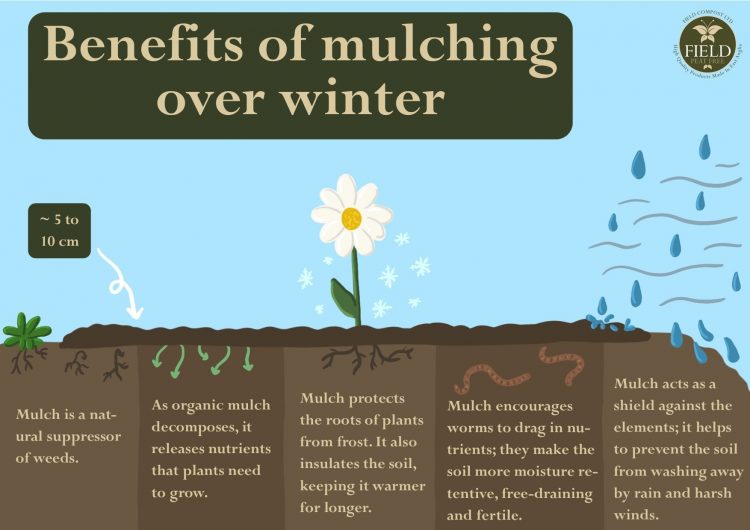
How to use mulches:
On each product page and their specification sheets, you can find more information and directions for use. But here we have provided general instructions and tips on how to mulch.
- Prepare the soil before: remove weeds by forking out perennials and pulling out annuals by hand. Also rake the surface of soil to level out the dips and hollows.
- Water the soil before you start mulching; moist soil keeps the water in. But don’t mulch when the soil is frozen.
- It is better not to mulch ground covering Mediterranean plants like thymus species. Mulching these species can hold too much moisture around stems and foliage.
- Apply mulches around spring bulbs, under hedges, around herbaceous perennials, and around fruit trees and bushes.
- Using your hand, a garden spade or fork, apply around 5 to 10 cm of mulch around the plant beds and key plants, without smothering or damaging lower stems. A thick layer will suppress more weeds, but bulbs and other plants may find it hard to grow through more than 5cm. It is suggested that biodegradable mulches need to be between 5cm and ideally 7.5cm thick.
- After mulching, use a rake or garden hoe to spread and ensure an even coverage across soil.
Problems and tips:
- When planting trees and shrubs, try not to mulch right up to the stems of these plants – leave a moat of space between the mulch and the base. Direct contact between wet mulch and stems can soften or even rot them.
- After mulching, you may need to apply extra water to reach the roots of plants beneath. But do not water too frequently; mulch can help rain soak into the soil and cause less water to evaporate.
- Use a rake to thin out the mulch after applying as mulching too thickly can prevent bulbs and herbaceous plants from growing.
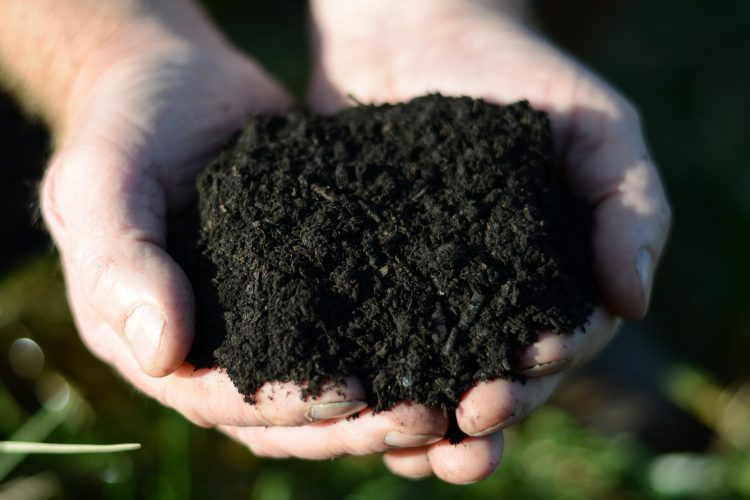
Our winter mulches:
These are the following mulches we recommend for use over autumn and winter:
a. Field No.1 Organic Soil Improver:
- To use on borders and lawns.
- Contains and high quantity of organic matter which gradually releases important nutrients as and when the plant needs it.
b. Field No.12 Nutrimulch:
- To use when mulching vegetables beds and ornamental borders.
- Is more fibrous than Field No.1 and has more available nutrients.
